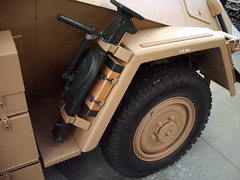It's actually a pretty interesting question!
Two somewhat conflicting answers pop into my head...
One is that there were likely "official" and approved jack-points - probably at the front and rear ends. And the crew were trained in using the supplied jack and in positioning it just so... "See page 23 of the Operator's Manual, Dummkopf!"

(But I packed my references for my pending cross-country relocation, and cannot provide you any verification of this!

The other is the one which has applied to my entire of almost 5 decades behind various types of "wheels" (including cars, ATV, light and medium commercial stuff, and all sorts of military stuff including small and large tactical / off-road trucks)... And which probably has applied to about all of us when doing a flat somewhere on something... The exact circumstances of the vehicle will determine where you can place your jack.

And, "where there's a will, there will be a way".

I am absolutely sure that those guys did whatever they needed to.
I did take a moment to examine my 3 221 and 223 builds for possible points that "might make sense"... The front and rear ends offer multiple possibilities for getting one of those jack-dogs (the "step") pretty well-positioned. I could also see using the side-hatch openings for the top foot of the jack. One could also use the wheel-hub itself - put the jack-dog under the hub, raise the tire sufficiently, blocks under that suspension-arm, lower the jack, swap the wheel, put the jack back under that hub, lift off the blocks and lower it to the ground. That may well have been the official way...

Great question, and someone out there will come up with some other answers!

Cheers!



































 Maybe just below the rear cowling for the engine ...
Maybe just below the rear cowling for the engine ...

















 (But I packed my references for my pending cross-country relocation, and cannot provide you any verification of this!
(But I packed my references for my pending cross-country relocation, and cannot provide you any verification of this! 
 And, "where there's a will, there will be a way".
And, "where there's a will, there will be a way".  I am absolutely sure that those guys did whatever they needed to.
I am absolutely sure that those guys did whatever they needed to.






































